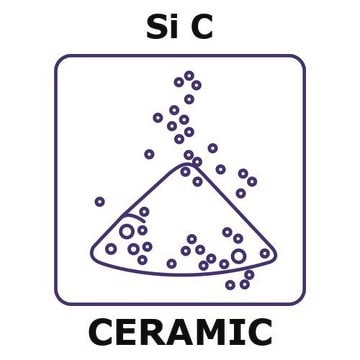594911
Silicon carbide
nanopowder, <100 nm particle size
Sinônimo(s):
Carbon silicide, Carborundum, Methanidylidynesilanylium, Silicon monocarbide
About This Item
Produtos recomendados
forma
nanopowder
área da superfície
70-90 m2/g
tamanho de partícula
<100 nm
pf
2700 °C (lit.)
densidade
3.22 g/mL at 25 °C (lit.)
densidade volumétrica
0.069 g/cm3
cadeia de caracteres SMILES
[C-]#[Si+]
InChI
1S/CSi/c1-2
chave InChI
HBMJWWWQQXIZIP-UHFFFAOYSA-N
Procurando produtos similares? Visita Guia de comparação de produtos
Categorias relacionadas
Descrição geral
Aplicação
- Overview of silicon carbide power devices: This document provides a comprehensive review of the characteristics and applications of silicon carbide (SiC) in power devices, discussing its advantages over traditional silicon devices in handling high voltages and efficiencies (Choi, 2016).
forma física
Código de classe de armazenamento
11 - Combustible Solids
Classe de risco de água (WGK)
nwg
Ponto de fulgor (°F)
Not applicable
Ponto de fulgor (°C)
Not applicable
Equipamento de proteção individual
dust mask type N95 (US), Eyeshields, Gloves
Certificados de análise (COA)
Busque Certificados de análise (COA) digitando o Número do Lote do produto. Os números de lote e remessa podem ser encontrados no rótulo de um produto após a palavra “Lot” ou “Batch”.
Já possui este produto?
Encontre a documentação dos produtos que você adquiriu recentemente na biblioteca de documentos.
Os clientes também visualizaram
Artigos
Composite materials with micron scale reinforcements offer tailored properties for various applications.
Silica's versatility spans various industries, including biomedical applications.
Three approaches generate white light, including LED-based down-conversion for broader applications.
Nossa equipe de cientistas tem experiência em todas as áreas de pesquisa, incluindo Life Sciences, ciência de materiais, síntese química, cromatografia, química analítica e muitas outras.
Entre em contato com a assistência técnica



